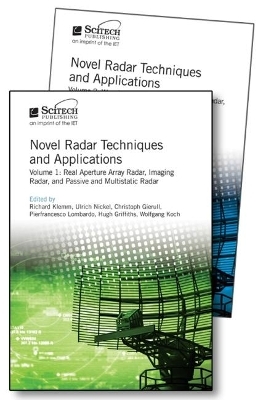
Novel Radar Techniques and Applications: 2 Volume Set
SciTech Publishing Inc
978-1-61353-229-4 (ISBN)
Volume 1 covers:
Real aperture array radar, including target parameter estimation and array radar features; robust direct data domain processing; and array radar operation management.
Imaging radar, including VideoSAR imaging for real-time persistence; high-resolution wide-swath SAR; interferometric SAR imaging; space-based SAR-Ground moving target indication; 3D & tomographic SAR imaging; bi- and monostatic SAR-GMTI; multistatic and MIMO ISAR techniques; and focussing moving objects using the VSAR algorithm.
Passive and multistatic radar, including bistatic clutter modeling; airborne passive radar; forward scatter radar; through the wall imaging radar; short-range passive radar potentialities; GNSS-based passive radar; passive radar with airborne receivers; multi-illuminator and multistatic passive radar; and passive MIMO radar networks.
Volume 2 covers:
Waveform diversity and cognitive radar, including holistic design of physical radar emissions; waveform design for spectral coexistence; adaptive OFDM waveform design for spatio-temporal-sparsity exploited STAP radar; applications of noise radar; bioinspired radar techniques; concept of the intelligent radar network; clutter diversity; and cognitive radar management.
Target tracking and data fusion, including posterior Cramér-Rao bounds for target tracking; tracking and fusion in log-spherical state space with application to collision avoidance and kinematic ranging; multistatic tracking for passive radar applications; radar-based ground surveillance; multiplatform radar surveillance for aerial and maritime surveillance; person tracking and data fusion for UWB radar applications; and sensor management for radar networks.
Richard Klemm has recently retired after a distinguished career at FGAN FHR (now Fraunhofer FHR), a research institute working in the areas defence and security, and decades of service to the radar community. Ulrich Nickel has recently retired after a career as head of the research group Data Fusion for Array Sensors of the Sensor Data and Information Fusion (SDF) Department of Fraunhofer FKIE in Wachtberg, Germany. Christoph H. Gierull is a Senior Scientist with Defence R&D Canada, Ottawa Research Centre assuming the duties of Group Leader, Space-based Radar as well as Adjunct Professor at Laval University, Quebec and Simon Fraser University, British Columbia, Canada. Pierfrancesco Lombardo is Full Professor at University of Rome "La Sapienza", where he leads the "Radar, Remote Sensing and Navigation" (RRSN) group. Hugh Griffiths holds the THALES/Royal Academy Chair of RF Sensors in the Department of Electronic and Electrical Engineering at University College London, England. Wolfgang Koch is head of the Sensor Data and Information Fusion (SDF) Department at Fraunhofer FKIE, an institute of the Fraunhofer Society, the largest institution for applied research in Europe.
Volume 1
Part I: Real aperture array radar
Chapter 1: Target parameter estimation and array features
Chapter 2: Robust direct data domain processing for MTI
Chapter 3: Array radar resource management
Part II: Imaging radar
Chapter 4: VideoSAR imaging for real-time persistent surveillance
Chapter 5: High-resolution wide-swath SAR
Chapter 6: SAR interferometry
Chapter 7: Space-based SAR ground moving target indication
Chapter 8: Interferometric and tomographic SAR
Chapter 9: Bi- and monostatic SAR-GMTI
Chapter 10: Multistatic and MIMO ISAR techniques
Chapter 11: Focussing moving objects using the VSAR algorithm
Part III: Passive and multistatic radar
Chapter 12: Bistatic clutter modelling
Chapter 13: Forward scatter radar
Chapter 14: Radar imaging of building interiors
Chapter 15: Short-range passive radar potentialities
Chapter 16: GNSS-based passive radar
Chapter 17: Airborne passive radar
Chapter 18: Multi-illuminator and multistatic passive radar
Chapter 19: Passive MIMO radar networks
Volume 2
Part I: Waveform diversity and cognitive radar
Chapter 1: Radar emission spectrum engineering
Chapter 2: Adaptive OFDM waveform design for spatio-temporal-sparsity exploited STAP radar
Chapter 3: Cognitive waveform design for spectral coexistence
Chapter 4: Noise Radar Technology
Chapter 5: Cognitive radar management
Chapter 6: Clutter diversity
Chapter 7: Biologically inspired processing of target echoes
Chapter 8: The concept of the intelligent radar network
Part II: Target tracking and data fusion
Chapter 9: Posterior Cramér-Rao bounds for target tracking
Chapter 10: Tracking and fusion in log-spherical state space with application to collision avoidance and kinematic ranging
Chapter 11: Multistatic tracking for passive radar applications
Chapter 12: Radar-based ground surveillance
Chapter 13: Radar multi-platform system for air surveillance
Chapter 14: People tracking and data fusion for UWB radar applications
Chapter 15: Sensor management for radar networks
| Erscheint lt. Verlag | 1.2.2018 |
|---|---|
| Reihe/Serie | Radar, Sonar and Navigation |
| Verlagsort | New York |
| Sprache | englisch |
| Maße | 156 x 234 mm |
| Themenwelt | Technik ► Nachrichtentechnik |
| ISBN-10 | 1-61353-229-6 / 1613532296 |
| ISBN-13 | 978-1-61353-229-4 / 9781613532294 |
| Zustand | Neuware |
| Haben Sie eine Frage zum Produkt? |